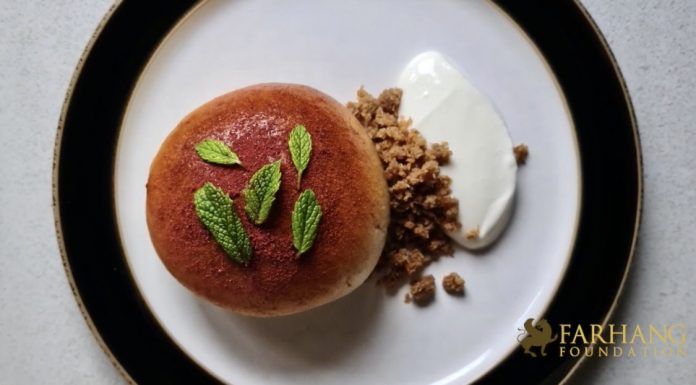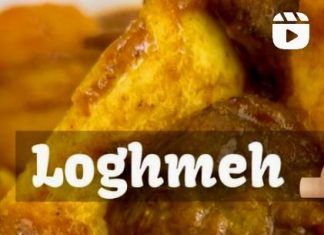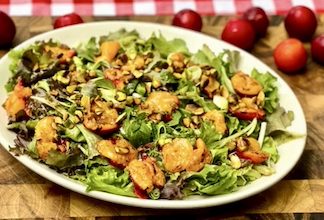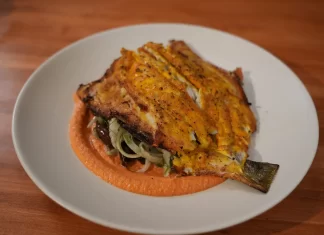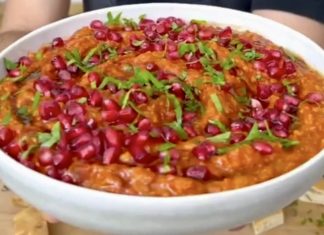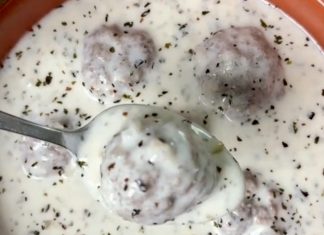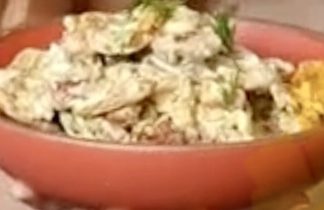In this week’s episode of #FarhangFlavor, Farhang Foundation travels to London to visit innovative Iranian chef Ashkan Ashtari at his home kitchen and learn about his new vision for “Pirashki,” an old Iranian delight by way of Russia.
“There are few dishes in Iranian cuisine which originate from Russia. The most well-known of these dishes is “Salad Olivieh.” Although not as well known, “Pirashki,” a leavened baked delight, has found its way to the heart of many Iranians. These can be found throughout Iran both in summer and winter, served cold or hot and with either sweet or savory fillings. As a much-loved street food in Iran, it is one of the most versatile on-the-go foods. Whilst sweet varieties, filled with custards or jams, are the norm, savory varieties are worth exploring due to many local variations which are based on regional produce. Lamb and aubergine (eggplant) have a special symbiotic flavor combination and can be found throughout Persian cuisine. Furthermore, the inspiration for the lamb and aubergine “Pirashki” comes from the Varamin county. This is partially because of the great quality of aubergines found in Varamin, but also due to the Russian influence in the region. For instance, the Russian-Iranian architect, Nikolai Markov built some of the most important buildings in Iran, such as the first sugar refinery in the Middle East, located in Varamin.
As an Iranian chef who has been working in the hospitality industry, I believe that Iranian cuisine has not entered the modern gastronomy scene. There may be several reasons for this, from the limited number of professional individuals in the industry, the strong presence of home cooking and the revolution of 1979. The latter, in my belief, is a key element to this as many doors have remained closed. Consequently, Iranian food has lagged behind those in the region with a lesser food cultural identity. Cooking in a gastronomic way means adapting techniques and improving flavor profiles and not essentially just plating a dish in a different way. As a result of this many indigenous ingredients are being lost from our arsenal of cooking and many antique techniques are disappearing. My inspiration stems from the conservation of Iranian cuisine, and the various preservation and cooking techniques utilized. Only knowing what our predecessors did with our food will allow us to evolve Iranian food. This takes a lot of research and hard work, learning from others and appreciating food as a collective.” – Ashkan Ashtari
Ingredients:
Pirashki Dough:
- 500g flour
- 200g buttermilk
- 80g water
- 60g lamb fat/butter/lard
- 35g egg yolk
- 8g yeast
- 15g caster sugar
- 8g salt
- Black aubergine (eggplant) and lamb belly stuffing:
- 2 aubergines (eggplants)
- 250g lamb belly mince (high fat more ideal)
- 150g lamb stock
- 12g chopped garlic (around 3 cloves)
- 150g diced medium red onions (around 1.5 onions)
- 1 mild chili
- 1tsp turmeric
- 1tsp cayenne pepper
- 1tsp dried lime powder
- 50ml verjus (unripened grape juice)
- ~3g salt (adjust accordingly)
Egg wash:
- 1 egg
- 70ml milk
Instructions:
Pirashki Dough
Start by making a wet mix. Warm up the buttermilk and water to 35-40 °C (95-104 °F) in the microwave, add sugar, egg yolk, and yeast and whisk. Leave covered for 4-5 minutes. Melt the lard and incorporate it into the wet mixture after 4-5 minutes. Slowly add flour to form the dough. Add salt at the last stage and work through for 4 minutes in a stand mixer. Leave in a warm environment to prove for 2-3 hours or until the dough has doubled in size. Whilst dough is proofing, make the filling. Chargrill the aubergines (eggplants) until the skins blister and smoke, and aubergine water appears. Place the aubergines in a sealed container and leave to steam in their own heat. Whilst the aubergines steam, brown the lamb belly mince in a pan without adding any oil (if using low-fat percentage mince, add some oil). Once browned, remove the mince and, in the same pan, sweat off onions until they are translucent and soft, then add garlic and chili. Once cooked, re-introduce the mince to the pan and add the spices. Deglaze the pan with the stock and cook until the mix forms a thick glaze. Add black pepper and adjust seasoning. Add the verjus.
Trim the aubergine and peel if necessary. Blend the aubergine to a fine paste and fold into the mince mix. Place in a container and leave to cool in the fridge. To assemble; portion the dough into 15 balls (roughly 60grams each). Roll out the dough into circles and place a good amount of stuffing in the middle. Fold over the dough and pinch/press the ends to close the tips. Any area which is open will cause the stuffing to pour out. Place on a baking tray and leave to prove for 30-45 mins. Apply an egg wash and bake in a preheated oven at 180°C (350°F) for 12-15 minutes or until golden brown.



